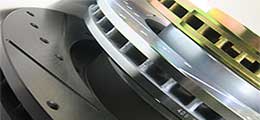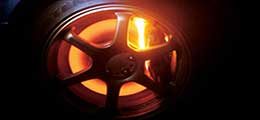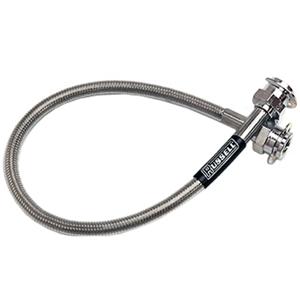
Stainless Steel Brake Brake Line
Overview
There are two different types of brake lines that can be installed on a vehicle; rubber and stainless steel. Of these, rubber brake lines are much cheaper than their stainless steel counterparts.
Rubber brake line installations are much more common, because the average everyday vehicle owner won’t notice the difference in braking response that comes from using rubber brake lines.
Rubber Style Brake Lines
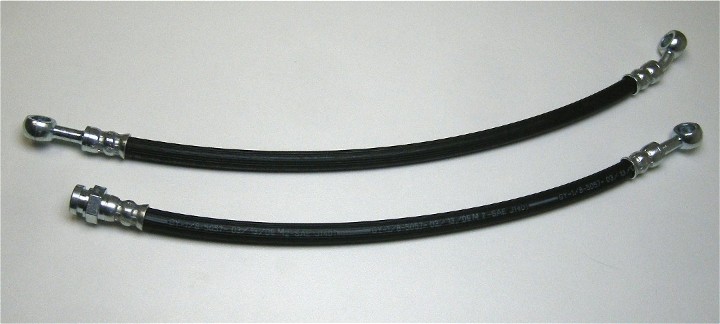
Technical Differences Between Rubber Versus Steel
At the layering level, stainless steel brake lines are somewhat similar to standard rubber brake lines as they both have flexible hoses encapsulated by a rigid shell.
If you were to cut a rubber brake line in half, you would notice there is nylon weave that serves as the skeleton to keep the hose rigid. This nylon shell is sandwiched between two separate rubber layers to do this job.
In a stainless steel brake line however, you would see an inner brake line material made of PTFE or Teflon that serves to route the brake fluid, and a stainless steel outer shell. Teflon is used because it is chemically inert, resists cracking, and does not expand under pressure.
Stainless steel brake lines have a braided steel outer shell mostly to protect the Teflon brake line from rocks or debris from the road, but it also does serve to increase the rigidity of the brake line as well.
Any type of brake fluid is compatible with stainless steel brake lines, so you don’t have to worry about compatibility issues when using them.
More About Using Stainless Steel
Stainless steel brakes lines serve in many high performance braking systems because Teflon resists expansion as mentioned above, and therefore creates more direct fluid pressure. A standard rubber brake line, when faced with over 1500 PSI of pressure at the point of brake application, will flex and absorb some of the pressure from the brake fluid compression. In a stainless steel brake line, brake fluid will only flow to the path of least resistance which usually ends up being the end of the brake line or caliper in a sealed system.
There are some drawbacks to using stainless steel brake lines however. If you happen to run a stainless steel brake line close to something that is soft or easily prone to abrasion, the stainless steel braid can tear up these surfaces as the brake line shreds materials during vehicle jarring.
Also, if dirt finds its way in between the steel braid and the Teflon in a stainless steel brake line, an abrasive environment will be created that will compromise the Teflon over time. You will often find that manufacturers of stainless steel brake lines encapsulate the stainless steel braid with a coat of plastic to keep dirt out, to remedy this weakness.
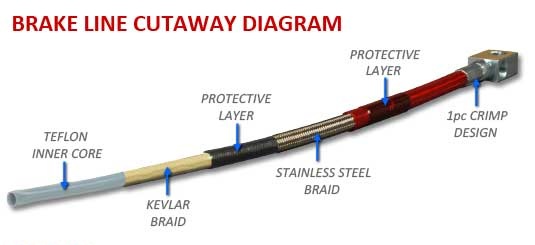
*Source: www.dieselpowerproducts.com
Braking Performance Gains With Stainless Steel
Some people think that by upgrading to stainless steel brake lines they will be able to increase their caliper clamping pressure or brake torque. The truth of the matter is that a stainless steel brake line upgrade will only increase the brake fluid pressure vs volume relationship, and not the brake fluid pressure vs brake torque relationship.
By doing the upgrade, you will have effectively decreased the amount of time it takes to build up critical pressure in your brakes’ hydraulic system to activate your calipers at their maximum level. Pressure created in your hydraulic system will not be increased overall, it will simply take more brake pedal travel distance to effectively build that brake line pressure needed to fully activate your braking calipers. This results overall, in a more responsive brake pedal.
If you are planning to upgrade your old or worn out brake lines anyway, then a stainless steel brake line upgrade might not be a bad idea if you are looking to decrease your stopping distance a bit more. Less pedal travel required to activate your brakes will decrease the amount of time for deceleration, and it may be worth it to you if you have already upgraded much of your other braking systems components.
If you do happen to perform the upgrade, you will need to monitor your braking performance regularly, as stainless brake line problems are not visible to the eye. This is due to the simple fact that the stainless steel braided mesh hides compromises to the Teflon brake line when present.



